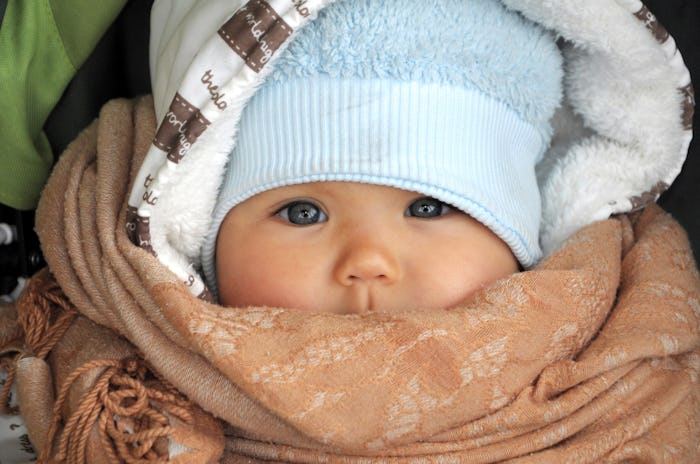Life

7 Signs of Frostbite In Babies That Should Be Noticed As Early As Possible
Winter is coming quickly, which means it's time to get prepared. Aside from stocking up on wood for the fire, new blankets for the bed, and scarves and sweaters for bundling, parents of young children have to make sure they're prepared to prevent frostbite. Since babies are able to communicate their ailments, parents have to be well-versed on the different signs of frostbite in babies so that they are able to stay healthy during winter.
Frostbite, though rarely talked about it, is very serious. According to Nationwide Children's, frostbite affects children more than adults and occurs on small, exposed areas of the body such as the nose, ears, fingers, and cheeks. If frostbite is not treated, it can cause the skin to turn black and, unfortunately, lead to amputation.
With babies, finding out what areas are cold or are in pain is very difficult. So, when it comes to noticing frostbite, parents have to pay close attention to the way their baby's skin looks and feels. Though frostbite can be treated, taking the necessary preventative measures will help you from dealing with a baby in pain.
Even with all of your knowledge as a parent, things happen. So, if at any point during this winter you think frostbite hit your baby, here are seven signs that will let you know if you're correct.
1Their Body Is Swollen
According to Nationwide Children's, swelling could be an early sign of frostbite. Instead of rubbing or massage the swollen area, put the injured area in warm water for 30 minutes or until the area turns pink.
2Their Skin Is Paler Than Normal
WebMD noted that if your baby's skin is paler than normal, they could be suffering from frostbite, too. Loosely layer their clothes to help prevent them from experiencing frostbite.
3Their Skin Looks Shiny Or Waxy
Mayo Clinic noted that shiny or waxy skin can be is a sign of frostbite. Because frostbite usually comes with numbness, your baby may not be able to cry out about it. Be sure to pay close attention to their skin.
4Their Skin Is Cold, Firm And Dry
Nationwide Children's also noted that if your baby has cold, firm and dry skin, it could be because they are experiencing frostbite. Do your best to avoid exposing your child to cold weather for a long period of time as cold wind will increase their chances of having frostbite.
5They're Experiencing Pain, Tingling, Burning, Or Aching
According to the University of Rochester Medical Center if your baby is experiencing pain, tingling, burning, or aching, they may be feeling symptoms of frostbite. Stay calm, move your child to a warm area and immerse the area into warm water.
6They Have Blisters Within 24-Hours Of Exposure
National Children's also noted that if you notice blisters within 24 hours of exposure to the cold, this could be a sign of frostbite, too. Be sure that you don't break the blisters when in the warming stages of nursing your child back to health.
7Their Skin Is Turning Black or Blue
In the advanced stage of frostbite, the skin can began to turn black or blue, according to WebMD. Again, as the frostbite gets worse, the area is hard to feel. Be sure to pay very close attention to the changes in skin color when you're outside in the cold.